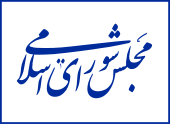Islamic Consultative Assembly
This article needs to be updated. (July 2023) |
Islamic Consultative Assembly مجلس شورای اسلامی Majles-e Showrā-ye Eslāmī | |
|---|---|
| 11th term | |
 | |
 | |
| Type | |
| Type | |
| History | |
| Founded | 16 November 1906 14 March 1980 (current form) |
| Preceded by | National Consultative Assembly |
| Leadership | |
Mohammad Bagher Ghalibaf since 28 May 2020 | |
First Vice | Ali Nikzad since 25 May 2021 |
Second Vice | Abdolreza Mesri since 25 May 2021 |
| Structure | |
| Seats | 290[1] |
 | |
Political groups |
|
Length of term | 4 years[1] |
| Elections | |
| Qualified majority two-round system[1] | |
Last election | 21 February and 11 September 2020 |
Next election | 2024 |
| Meeting place | |
 | |
| Islamic Consultative Assembly Baharestan Tehran Iran | |
| Website | |
| http://www.Majlis.ir | |
| Constitution | |
| Constitution of the Islamic Republic of Iran | |
The National Consultative Assembly of Iran, also called The Iranian Parliament or People's House, is the national legislative body of Iran. The Parliament has 290 representatives. There were 272 seats since the 18 February 2000 election. The election took place on 2 March 2012. The new parliament will be opened on 27 May 2012.[2]
History
[change | change source]The first national assembly
[change | change source]The first national assembly, the "Majlis", was formed in 1906, after the 1905-1906 revolution. The Majlis wrote a constitution for the Persian empire.[3] The first Majlis had 156 delegates. Tehran had 60 of the 156 seats. Major provinces like Azerbaijan had 12 delegates. Smaller provinces like Gilan and Tavala had 6 delegates each.[4]
War
[change | change source]In 1941, Britain and Russia invaded Persia to put the Germans out. This happened during the 13th Majlis. Mohamed Reza Shah was the constitutional monarch from 1941–1953. From 1953 until the revolution of 1979, Shah was the absolute ruler. Elections for the 14th Majlis were in 1943. In 1950, a special assembly met to create a new upper house, or senate, with half of the members appointed by Shah. The assembly also gave Shah the power to dissolve the national assembly.[5] The 21st Majlis was elected in September 1963.[6]
The 1979 revolution
[change | change source]After the revolution, Iran changed the name of the parliament from the National Assembly to the Islamic Assembly.[7]
Elections after the revolution
[change | change source]Dates of elections:[8]
- 1st Majlis 1979-83
- 2nd Majlis 1983-87
- 3rd Majlis 1987-91
- 4th majlis 1991-96
- 5th Majlis 1996-00
- 6th Majlis 2000-04
References
[change | change source]- ↑ 1.0 1.1 1.2 1.3 Nohlen, Dieter; Grotz, Florian; Hartmann, Christof (2001). "Iran". Elections in Asia: A Data Handbook. Vol. I. Oxford University Press. p. 64. ISBN 0-19-924958-X.
- ↑ "Large-scale turn out at polls in IRI March Majlis Elections: Polls". Archived from the original on 2012-02-02. Retrieved 2012-05-20.
- ↑ Ehteshami, Anoushiravan (3 February 2017). Iran: Stuck in Transition. Taylor & Francis. ISBN 9781351985451 – via Google Books.
- ↑ Afary, Janet (10 June 1996). The Iranian Constitutional Revolution, 1906-1911: Grassroots Democracy, Social Democracy, & the Origins of Feminism. Columbia University Press. ISBN 9780231103510 – via Google Books.
- ↑ Katouzian, Homa (1 June 2013). Iran: A Beginner's Guide. Oneworld Publications. ISBN 9781780742731 – via Google Books.
- ↑ Curtis, Glenn E.; Hooglund, Eric (10 June 1997). Iran-A Country Study. Government Printing Office. ISBN 9780844411873 – via Google Books.
- ↑ Saleh, A. (17 July 2013). Ethnic Identity and the State in Iran. Springer. ISBN 9781137310873 – via Google Books.
- ↑ Khiabany, Gholam (10 September 2009). Iranian Media: The Paradox of Modernity. Routledge. ISBN 9781135894900 – via Google Books.
35°41′30.28″N 51°26′04″E / 35.6917444°N 51.43444°E
